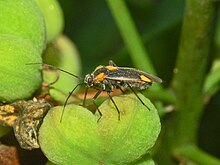
Coppicing is the traditional method in woodland management of cutting down a tree to a stump, which in many species encourages new shoots to grow from the stump or roots, thus ultimately regrowing the tree. A forest or grove that has been subject to coppicing is called a copse or coppice, in which young tree stems are repeatedly cut down to near ground level. The resulting living stumps are called stools. New growth emerges, and after a number of years, the coppiced trees are harvested, and the cycle begins anew. Pollarding is a similar process carried out at a higher level on the tree in order to prevent grazing animals from eating new shoots. Daisugi, is a similar Japanese technique.

The heath fritillary is a species of butterfly in the family Nymphalidae. It is found throughout the Palaearctic from western Europe to Japan, in heathland, grassland, and in coppiced woodland. Its association with coppiced woodland earned it the name "woodman's follower" in parts of the UK. It is considered a threatened species in the UK and Germany, but not Europe-wide or globally.

Ophrys insectifera, the fly orchid, is a species of orchid and the type species of the genus Ophrys. It is remarkable as an example of the use of sexually deceptive pollination and floral mimicry, as well as a highly selective and highly evolved plant–pollinator relationship.

Oberthür's grizzled skipper is a species of skipper.

Adelphocoris lineolatus, is commonly known as the Lucerne bug or the alfalfa plant bug, and belongs to the family Miridae. It is an agricultural pest causing vast amounts of damage to numerous crops, but primarily to alfalfa crops around the globe.

Stenotus binotatus is a species of plant bug, originally from Europe, but now also established across North America and New Zealand. It is 6–7 mm (0.24–0.28 in) long, yellowish, with darker markings on the pronotum and forewings. It feeds on various grasses, and can be a pest of crops such as wheat.

Lygus pratensis is a species of plant bug belonging to the family Miridae.

Deraeocoris ruberis a species of bug in the Miridae family.

Harpocera thoracica is a species of bugs from Miridae family.

Heterotoma planicornis is a species of bug from Miridae family.

Closterotomus biclavatus is a plant bug belonging to the family Miridae, subfamily Mirinae. The species was first described by Gottlieb August Wilhelm Herrich-Schäffer in 1835.

Phylus melanocephalus is a European species of plant bugs belonging to the family Miridae, subfamily Phylinae. It is a slender bug 4.5–6 millimetres (0.18–0.24 in) long and feeds on oak trees. Its colour ranges from orange to greenish-brown and its head may be pale or dark.

The black-headed sugar ant, also known as the brown sugar ant, is a species of Formicinae ant endemic to Australia. Found throughout most states, the species is a member of the genus Camponotus, a cosmopolitan genus of ants commonly known as carpenter ants. It was formally described and named by British entomologist Frederick Smith in 1858. These ants are characterised by their black head, reddish-brown mesosoma and black gaster, which can change in colour.
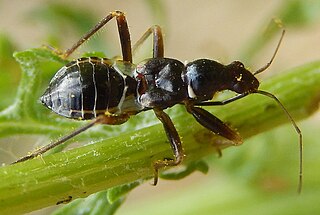
Myrmecoris gracilis is a species of flightless Hemipteran bug from the family Miridae. The genus Mymecoris is monotypic with one Palaearctic species. It differs in its outward appearance and way of life from other "grass bugs" in the Stenodemini, being predatory and an effective ant mimic.

Orthonotus rufifrons is a species of plant bugs belonging to the family Miridae.
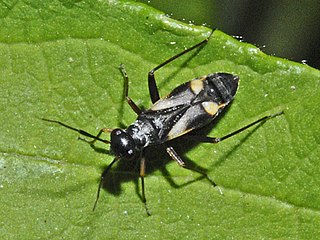
Globiceps fulvicollis is a species of plant-feeding insect of the family Miridae.
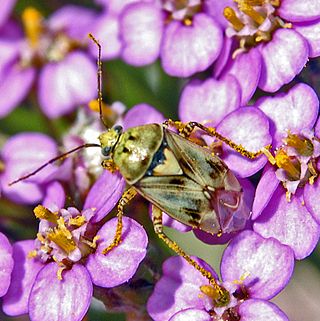
Lygus gemellatus is a species of plant-feeding insects in the family Miridae.
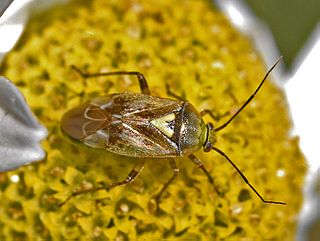
Lygus rugulipennis, the European tarnished plant bug, is a species of plant bugs of the family Miridae.

Placochilus seladonicus is a species of insect in the family Miridae, the plant bugs.

Plagiognathus arbustorum is a species of insects in the family Miridae, the plant bugs.

